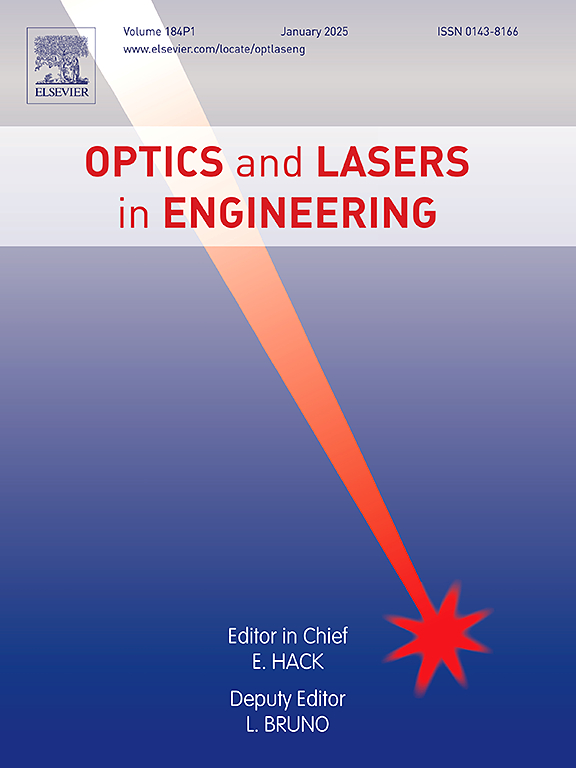Performance and analysis of pressure sensor with π-FBG on thick-walled cylinder for ultra-high oceanic pressure measurement
IF 3.7
2区 工程技术
Q2 OPTICS
引用次数: 0
Abstract
Accurate pressure measurements in deep-sea environments require ultra-high-pressure sensors that maintain high precision across a wide range of temperatures and pressures. This paper presents the design and performance analysis of an ultra-high-pressure sensor based on a thick-walled cylindrical π-phase-shifted fiber Bragg grating (π-FBG). The sensor consists of a π-FBG element, a pressure conversion unit, and a robust encapsulation structure. It operates efficiently within a pressure range of 2 to 120 MPa, with a pressure sensitivity of 5.884 pm/MPa and a measurement accuracy of 0.033 % Full Scale (F.S.), offering both a wide dynamic range and high precision. A modified finite element model (FEM) is developed, incorporating the composite structure of the π-FBG and adhesive interface, to optimize sensor design and improve analytical accuracy. Simulation results confirm the critical influence of structural and bonding parameters on pressure response and successfully predict the wavelength shifts induced by external pressure. The model also reveals key insights into the stress-strain behavior, interfacial strain transfer, and pressure sensitivity. To evaluate temperature effects on pressure sensitivity, controlled experiments were conducted at 2°C, 5°C, 8°C and 20°C, simulating deep-sea temperature environments. The results indicate a linear relationship between pressure sensitivity and temperature. A calibration equation is proposed to compensate for the temperature-induced deviations, maintaining a relative error less than 0.033 % F.S. throughout the 2–20°C range. The sensor features a compact design, straightforward fabrication, and simple calibration procedure, making it suitable for applications in extreme environments, such as deep-sea exploration and downhole pressure measurements. This work advances the analytical framework for π-FBG-based ultra-high-pressure sensors and contributes new insights into the development of next-generation deep-sea measurement technologies.
超高压海洋压力测量厚壁圆柱体π-FBG压力传感器性能与分析
在深海环境中进行精确的压力测量需要超高压传感器,在广泛的温度和压力范围内保持高精度。本文介绍了一种基于厚壁圆柱π移相光纤布拉格光栅的超高压传感器的设计和性能分析。该传感器由π-FBG元件、压力转换单元和坚固的封装结构组成。它在2至120 MPa的压力范围内有效工作,压力灵敏度为5.884 pm/MPa,测量精度为0.033%满量程(F.S.),提供宽动态范围和高精度。为了优化传感器设计,提高分析精度,提出了一种将π-FBG和胶粘剂界面结合的改进有限元模型。仿真结果证实了结构参数和键合参数对压力响应的重要影响,并成功地预测了外部压力引起的波长位移。该模型还揭示了应力-应变行为、界面应变传递和压力敏感性的关键见解。为了评估温度对压力敏感性的影响,模拟深海温度环境,在2°C、5°C、8°C和20°C下进行了对照实验。结果表明,压力灵敏度与温度呈线性关系。提出了一个校准方程来补偿温度引起的偏差,在2-20°C范围内保持相对误差小于0.033% F.S.。该传感器设计紧凑,制造简单,校准程序简单,适用于极端环境,如深海勘探和井下压力测量。该工作完善了基于π- fbg的超高压传感器的分析框架,为下一代深海测量技术的发展提供了新的见解。
本文章由计算机程序翻译,如有差异,请以英文原文为准。
求助全文
约1分钟内获得全文
求助全文
来源期刊

Optics and Lasers in Engineering
工程技术-光学
CiteScore
8.90
自引率
8.70%
发文量
384
审稿时长
42 days
期刊介绍:
Optics and Lasers in Engineering aims at providing an international forum for the interchange of information on the development of optical techniques and laser technology in engineering. Emphasis is placed on contributions targeted at the practical use of methods and devices, the development and enhancement of solutions and new theoretical concepts for experimental methods.
Optics and Lasers in Engineering reflects the main areas in which optical methods are being used and developed for an engineering environment. Manuscripts should offer clear evidence of novelty and significance. Papers focusing on parameter optimization or computational issues are not suitable. Similarly, papers focussed on an application rather than the optical method fall outside the journal''s scope. The scope of the journal is defined to include the following:
-Optical Metrology-
Optical Methods for 3D visualization and virtual engineering-
Optical Techniques for Microsystems-
Imaging, Microscopy and Adaptive Optics-
Computational Imaging-
Laser methods in manufacturing-
Integrated optical and photonic sensors-
Optics and Photonics in Life Science-
Hyperspectral and spectroscopic methods-
Infrared and Terahertz techniques
 求助内容:
求助内容: 应助结果提醒方式:
应助结果提醒方式:


